Triyuginarayan Temple: Journey to the Eternal Flame
Triyuginarayan Temple is a Hindu temple located in the Triyuginarayan village in Rudraprayag district, Uttarakhand, India. It is an ancient temple dedicated to Lord Vishnu, but its fame comes from the legend of Lord Shiva’s marriage to Goddess Parvati, which is believed to have taken place here. This association with the divine wedding makes it a popular pilgrimage site for Hindus.
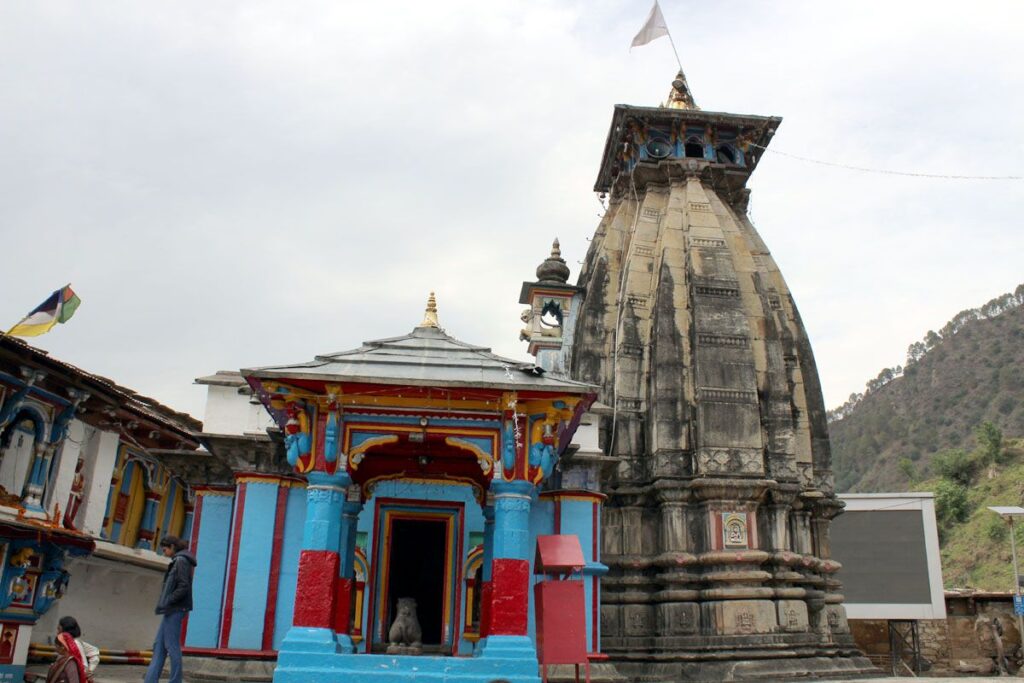
Contents
Triyuginarayan Temple History:
Mythological Origins:
- Divine Wedding: The temple’s fame primarily stems from the celebrated legend of Lord Shiva and Goddess Parvati’s celestial marriage. Believed to have occurred in Satya Yuga, the ceremony is said to have taken place at this very site, with the divine fire illuminating the event. The “Akhand Dhuni” (eternal flame) burning in the temple courtyard is considered a manifestation of that sacred fire, adding to the temple’s mystique.
- Temple’s Name and Existence: “Triyuginarayan” literally translates to “Narayana of the Three Yugas,” suggesting the temple’s presence across three cosmic ages: Satya Yuga, Treta Yuga, and Dwapara Yuga. This reinforces the legend and adds to the temple’s aura of antiquity.
Historical and Architectural Aspects:
- Construction and Attribution: Despite the mythological claims, historical records attribute the temple’s construction to Adi Shankaracharya in the 8th century AD. Its architectural style resembles the Kedarnath temple, further showcasing Shankaracharya’s influence in the region.
- Renovations and Rulers’ Contributions: Over time, various rulers contributed to the temple’s maintenance and expansion. Maharaja Pratap Shah of Tehri Garhwal is credited with building the present structure, showcasing the enduring devotion associated with the site.
Read More>> 12th Century Babulnath Temple Mumbai
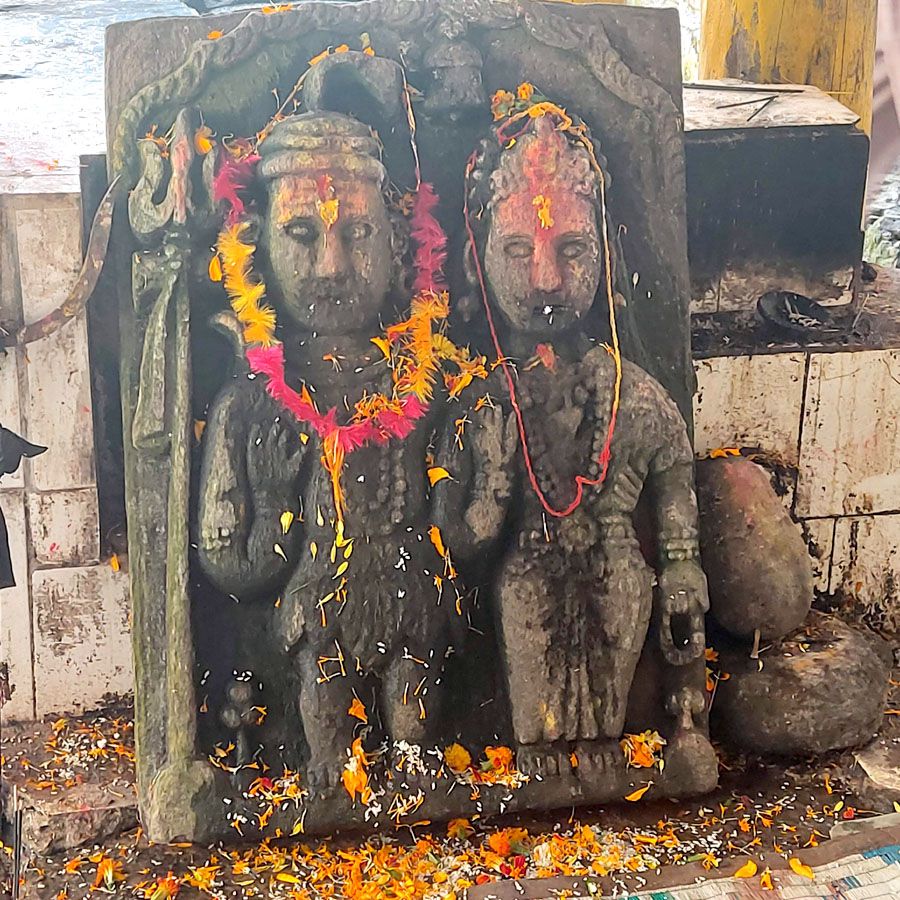
Legend of Triyuginarayan Temple:
The name “Triyuginarayan” literally translates to “Vishnu of the Three Yugas,” signifying a belief that the temple has existed for three cosmic ages – Satya Yuga, Treta Yuga, and Dwapara Yuga. While the exact origins of the temple remain shrouded in mystery, its association with the divine wedding adds an ethereal layer to its history.
Legend has it that Goddess Parvati, after years of penance at Gaurikund, finally won the heart of Lord Shiva. Their grand celestial wedding took place at Triyuginarayan, with none other than Lord Vishnu himself gracing the ceremony as the bride’s brother. The divine fire that ignited during the auspicious union is said to have never extinguished, burning continuously to this day. This eternal flame, known as the “Akhand Dhuni,” adds to the temple’s mystical aura and is a major draw for pilgrims seeking blessings for marital bliss and harmony.
Beyond the legend, Triyuginarayan Temple is a captivating architectural marvel. Built in the traditional Garhwali style, the temple features intricate stone carvings and a serene ambiance. The sanctum sanctorum houses a captivating idol of Lord Vishnu, flanked by Goddess Lakshmi and Saraswati.
The temple complex also boasts four sacred “kunds” or holy ponds – Rudra-kund, Vishnu-kund, Brahma-kund, and Saraswati-kund. These are believed to have been used by the deities for their pre-wedding bath and are considered to possess the power to cleanse sins and bestow blessings.
A visit to Triyuginarayan Temple is an experience that transcends religion. It’s a journey into the realm of ancient myths, breathtaking natural beauty, and spiritual solace. Whether you seek blessings, marvel at history, or simply soak in the serenity of the Himalayas, this sacred abode has something to offer everyone.
Read More>> Ardha Nareeswara Temple Hyderabad
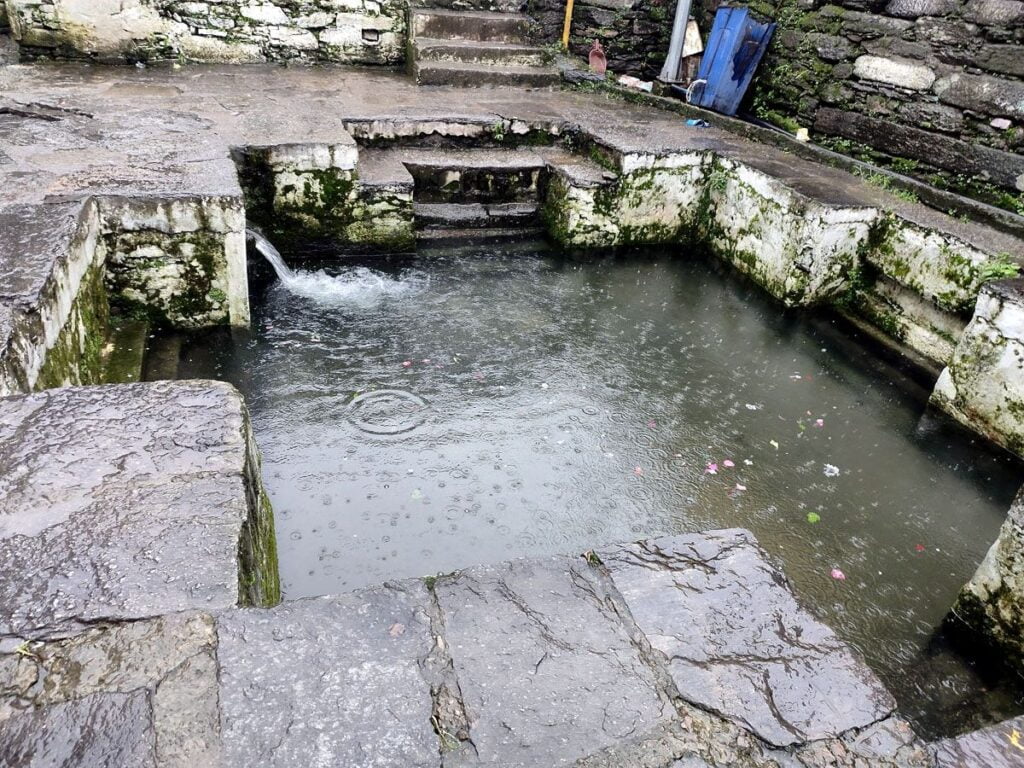
Myths and beliefs of Triyuginarayan Temple:
The Celestial Wedding:
- The legend that crowns Triyuginarayan’s fame is the celestial marriage of Shiva and Parvati. It’s believed that in the pristine beauty of this very location, during the Satya Yuga, the two divine beings tied the nuptial knot.
- The union, witnessed by deities and celestial beings, was solemnized by the holy fire that still burns eternally in the temple’s ‘Havan-kund’, a four-cornered fireplace. This eternal flame, known as ‘Akhand Dhuni’, is a tangible testament to the myth’s enduring power.
The Power of the Sacred Fire:
- Devotees hold the ‘Akhand Dhuni’ in immense reverence. The ashes from the fire are considered sacred, believed to possess the power to bless couples with everlasting marital bliss and harmony. Carrying these ashes home is a customary practice among pilgrims.
The Cleansing Waters:
- Before the divine wedding, the legend narrates that the gods bathed in four sacred kunds (ponds) – Rudra-kund, Vishnu-kund, Brahma-kund, and Saraswati-kund. Each kund is attributed to a specific deity, and their waters are believed to possess purifying and healing properties.
- Saraswati-kund, in particular, is said to have originated from Lord Vishnu’s navel, and its water is believed to be especially potent in curing infertility.
Lord Vishnu’s Penance:
- The temple’s name, Triyuginarayan, translates to “Vishnu of the Three Yugas.” Legend has it that Lord Vishnu performed intense penance here for three yugas – Satya Yuga, Treta Yuga, and Dwapara Yuga – seeking divine blessings. This association further adds to the temple’s spiritual significance.
Read More>> Kuchanur Saneeswaran Temple Swayambu Idol
A Panch Kedar Shrine:
- Triyuginarayan is revered as one of the Panch Kedar temples, a group of five shrines dedicated to Lord Shiva in the Garhwal Himalayas. Visiting all five temples is believed to be a highly meritorious act, washing away sins and granting spiritual liberation.
A Beacon of Spirituality:
- Beyond the enchanting myths, Triyuginarayan Temple stands as a powerful symbol of faith and devotion. The serene atmosphere, the breathtaking Himalayan backdrop, and the unwavering belief of countless devotees imbue the temple with an undeniable spiritual energy.
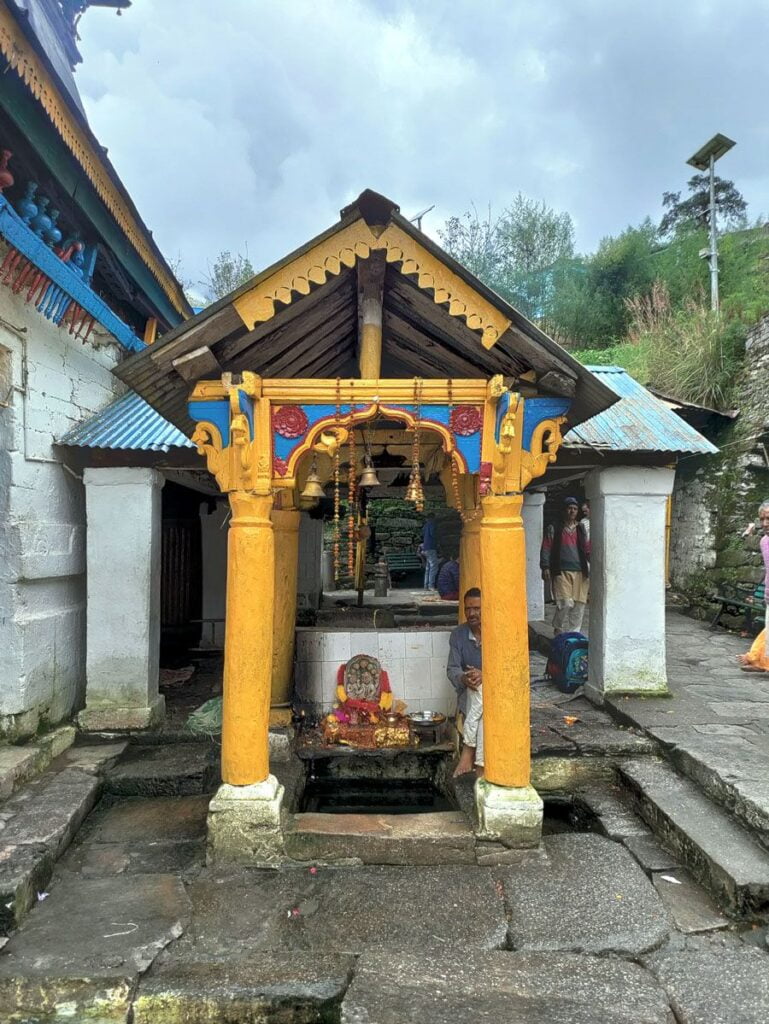
Significance of Triyuginarayan Temple:
The Triyuginarayan Temple holds significant value for Hindus for several reasons:
1. Religious Significance:
- Dedicated to Vishnu: The temple is primarily dedicated to Lord Vishnu, the preserver god in Hinduism. It houses a beautiful silver idol of Vishnu along with his consorts Lakshmi and Saraswati.
- Legend of Shiva and Parvati’s marriage: According to Hindu mythology, Triyuginarayan is the sacred site where Lord Shiva and Goddess Parvati were married. This association with the divine union further amplifies the temple’s importance.
- Perpetual Fire (Akhand Dhuni): A unique feature of the temple is the ‘Akhand Dhuni,’ a perpetually burning fire said to have been lit during Shiva and Parvati’s wedding. The fire symbolizes the eternal flame of love and commitment, attracting many devotees seeking blessings for marital bliss.
2. Historical and Cultural Significance:
- Architectural Resemblance to Kedarnath: The temple’s architecture bears a striking resemblance to the renowned Kedarnath shrine, adding to its historical and cultural value. This similarity attracts pilgrims visiting Kedarnath to also pay their respects at Triyuginarayan.
- Potential association with Adi Shankaracharya: Though lacking concrete evidence, the temple is sometimes attributed to the revered Hindu scholar Adi Shankaracharya, who revitalized Hinduism in the 8th century. This potential connection further boosts the temple’s historical significance.
3. Scenic Location:
- Located in the picturesque Garhwal Himalayas: The temple is nestled amidst the stunning scenery of the Garhwal Himalayas, offering breathtaking views of snow-capped peaks. This picturesque setting adds to the spiritual and pilgrimage experience.
Read More>> Nambunayaki Amman Temple Rameswaram
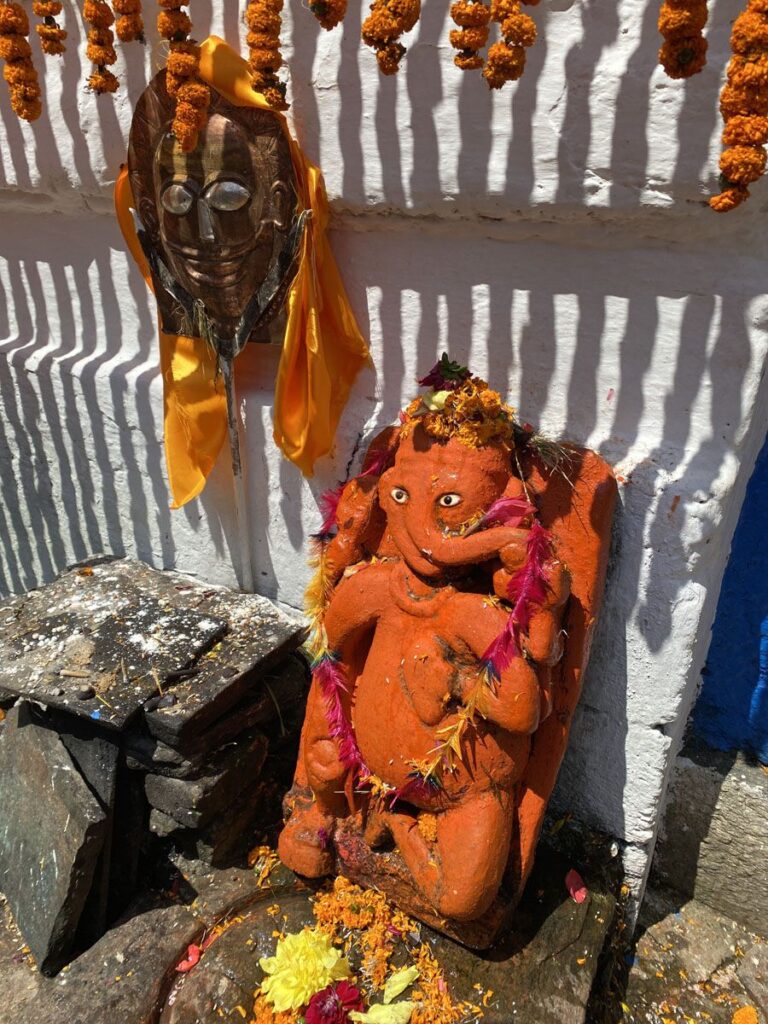
Triyuginarayan Temple Timing and Rituals:
Timings:
- Morning Darshan: 7:00 AM – 2:00 PM
- Evening Darshan: 4:00 PM – 8:00 PM
Rituals:
- Aarti: The devotional lamp offering is a central ritual performed several times a day, especially during morning and evening darshans. Witnessing the rhythmic chanting and the gentle swaying of the lamps is a mesmerizing experience.
- Havan: This sacred fire ritual involves offering oblations of ghee, grains, and herbs to the deities. The crackling flames and the fragrant smoke create a purifying and divine atmosphere.
- Bhajans: Devotees sing devotional hymns and songs in praise of Lord Vishnu, Shiva, and Parvati. The melodious chants resonate throughout the temple complex, creating a sense of peace and devotion.
- Special Pujas: Specific pujas are performed on auspicious occasions like festivals, birthdays, and anniversaries. These pujas can be customized based on individual needs and desires.
Other noteworthy rituals:
- Parvati Kund Snan: This annual festival celebrates the divine marriage of Lord Shiva and Goddess Parvati. Devotees take a holy dip in the Parvati Kund, a sacred pool near the temple.
- Akhand Dhuni: An eternal flame burns within the temple complex, symbolizing the continuous flow of devotion and spirituality. Devotees can offer wood to keep the flame burning.
- Wedding Ceremonies: The Triyuginarayan Temple is a popular destination for Hindu weddings. Couples seeking blessings for a blissful married life tie the knot amidst the serene temple surroundings.
Read More>> Komuravelli Mallanna Temple
Additional Information:
- Entry Fee: No entry fee is charged for visiting the temple.
- Photography: Photography is strictly prohibited inside the temple sanctum.
- Accommodation: Several hotels and lodges are available near the temple for pilgrims and travelers.
Planning your visit:
The best time to visit the Triyuginarayan Temple is between October and March when the weather is pleasant. However, be prepared for chilly temperatures, especially during the winter months.
Places to visit near Triyuginarayan Temple:
- Kedarnath Temple: One of the holiest Hindu shrines dedicated to Lord Shiva, Kedarnath Temple is located about 50 kilometers from Triyuginarayan. It is one of the Char Dham pilgrimage sites and is nestled amidst the breathtaking Himalayan mountains.
- Badrinath Temple: Another important pilgrimage site, Badrinath Temple is dedicated to Lord Vishnu. It is part of the Char Dham circuit and is situated about 160 kilometers from Triyuginarayan. The temple is surrounded by picturesque landscapes.
- Gaurikund: This is a hot water spring and a trekking base for the Kedarnath Yatra. It is located around 16 kilometers from Triyuginarayan and offers a serene environment amidst the mountains.
- Rudraprayag: The town of Rudraprayag is located at the confluence of the Alaknanda and Mandakini rivers. It is about 12 kilometers from Triyuginarayan and serves as a gateway to the Char Dham Yatra.
- Chopta: Often referred to as the “Mini Switzerland of Uttarakhand,” Chopta is known for its lush meadows and stunning views of the Himalayan peaks. It is around 30 kilometers from Triyuginarayan and is a great destination for nature lovers and trekkers.
- Tungnath Temple: It is the highest Shiva temple in the world and is part of the Panch Kedar pilgrimage. Tungnath is known for its scenic trekking route and is situated not far from Triyuginarayan.
- Deoria Tal: A pristine lake surrounded by lush forests and snow-capped peaks, Deoria Tal is a trekking destination located about 60 kilometers from Triyuginarayan. The trek offers breathtaking views of the Himalayan range.
- Chandrashila: If you’re an adventure enthusiast, you can consider trekking to Chandrashila, which offers panoramic views of the Himalayas. The trek starts from Chopta and passes through Tungnath.
FAQ:
Q: Where is the Triyuginarayan Temple located?
The Triyuginarayan Temple is nestled in the picturesque village of Triyuginarayan, nestled within the Rudraprayag district of Uttarakhand, India. Perched at an altitude of 1,980 meters, it offers breathtaking panoramic views of the snow-capped Garhwal Himalayas.
Q: To whom is the temple dedicated?
The ancient temple is primarily dedicated to Lord Vishnu, the preserver deity in the Hindu trinity. However, its fame stems from the legend associated with Lord Shiva and Goddess Parvati’s celestial wedding, which is believed to have taken place here. This association has made it a popular pilgrimage site for Hindus.
Q: What is the significance of the temple’s name?
The name “Triyuginarayan” translates to “Vishnu of the Three Yugas.” “Triyuga” refers to the three ages or yugas in Hindu cosmology – Satya Yuga, Treta Yuga, and Dvapara Yuga. The legend suggests that the temple has existed for these three ages, signifying its ancient and sacred status.
Q: What are some of the key features of the temple?
- Architectural Style: The temple bears a striking resemblance to the Kedarnath Temple in terms of its architectural style.
- Silver Idols: The sanctum sanctorum houses a 2-foot silver idol of Lord Vishnu (Narayana) along with his consorts, Goddess Lakshmi and Goddess Saraswati.
- Akhand Dhuni (Perpetual Fire): A unique feature of the temple is the Akhand Dhuni, an eternal flame that is believed to have been burning since the time of Lord Shiva and Parvati’s wedding. This fire symbolizes the enduring union and blessings associated with the temple.
- Havan Kund: In front of the temple lies the Havan Kund, a sacred fire pit where devotees offer oblations and prayers.
Q: What are some of the rituals and customs associated with the temple?
- Offering Wood to the Akhand Dhuni: Devotees often bring wood to offer to the Akhand Dhuni, seeking blessings for marital bliss and harmony. The ashes from the fire are considered sacred and taken back as prasad.
- Dips in the Holy Kunds: Three holy kunds dedicated to Brahma, Rudra, and Vishnu are located near the temple. Devotees take ritual dips in these kunds, believing it to be purifying and spiritually uplifting.
- Special Pujas: Specific pujas and ceremonies are performed on auspicious occasions like Shivratri and Janmashtami, drawing large crowds of devotees.
Q: How do I reach the Triyuginarayan Temple?
The temple is accessible by road from major towns like Rishikesh, Dehradun, and Haridwar. From Rishikesh, it is approximately a 230 km drive via the Badrinath-Kedarnath highway. Taxis and buses are readily available for transportation.
Additional Tips:
- The temple is open for darshan throughout the day, but the ideal time to visit is early morning or evening when the atmosphere is serene.
- Dress modestly and respectfully while visiting the temple.
- Photography is allowed within the temple complex, but avoid capturing close-ups of the deities.
- Be mindful of the local customs and traditions.
Q: Can we marry in Triyuginarayan temple?
Yes, you can get married in the Triyuginarayan Temple!
It’s become a popular destination for spiritual weddings, especially given its association with Lord Shiva and Parvati’s sacred union. However, there are some things to keep in mind:
- Limited Capacity: The temple has a relatively small capacity and can only accommodate up to 30 guests for wedding ceremonies. Consider this if you have a larger guest list.
- Booking Procedure: Marriages require prior booking and permission from the temple authorities. It’s advisable to contact the temple administration well in advance to discuss availability and procedures.
- Traditional Ceremonies: Ceremonies at the temple follow specific traditional rituals. You may need to collaborate with experienced pandits or local organizers familiar with the temple’s customs and conduct the ceremony smoothly.
- Seasonality and Accessibility: The temple remains accessible from May to November, while snow blocks road access during winter months. Plan your wedding accordingly to avoid travel disruptions.
Q: Which celebrity got married at Triyuginarayan temple?
While the Triyuginarayan Temple is a popular choice for spiritual weddings, there hasn’t been any majorly acclaimed Indian celebrity wedding that we know of that took place there. This might be due to the temple’s relatively limited capacity and its remote location compared to other popular wedding venues in India.
However, some television actors and personalities have tied the knot at Triyuginarayan:
- Nikita Sharma and Rohandeep Singh, known for their roles in Indian television serials, got married at the temple in 2021.
- Other actors like Kavita Kaushik and a few high-profile individuals have also chosen the temple for their wedding ceremonies.
So, while the Triyuginarayan Temple hasn’t yet hosted a high-profile Bollywood wedding, its spiritual significance and beautiful setting continue to attract couples seeking a unique and sacred union.
How to Reach Triyuginarayan Temple:
By Air: The nearest airport to Triyuginarayan Temple is Jolly Grant Airport in Dehradun, which is approximately 210 kilometers away. From the airport, you can hire a taxi or take a bus to Rudraprayag and then proceed to Triyuginarayan.
By Train: The nearest railway station is at Rishikesh, which is about 192 kilometers away. From Rishikesh, you can hire a taxi or take a bus to Rudraprayag and then make your way to Triyuginarayan.
By Road:
- From Delhi: Triyuginarayan is approximately 450 kilometers from Delhi. You can take a bus or hire a taxi from Delhi to Rudraprayag. From Rudraprayag, Triyuginarayan is around 30 kilometers away.
- From Haridwar: Triyuginarayan is around 220 kilometers from Haridwar. You can take a bus or hire a taxi to Rudraprayag and then proceed to Triyuginarayan.
- From Rishikesh: Rishikesh is around 190 kilometers from Triyuginarayan. You can take a bus or hire a taxi to Rudraprayag and then proceed to the temple.

One Comment